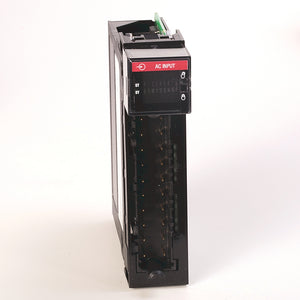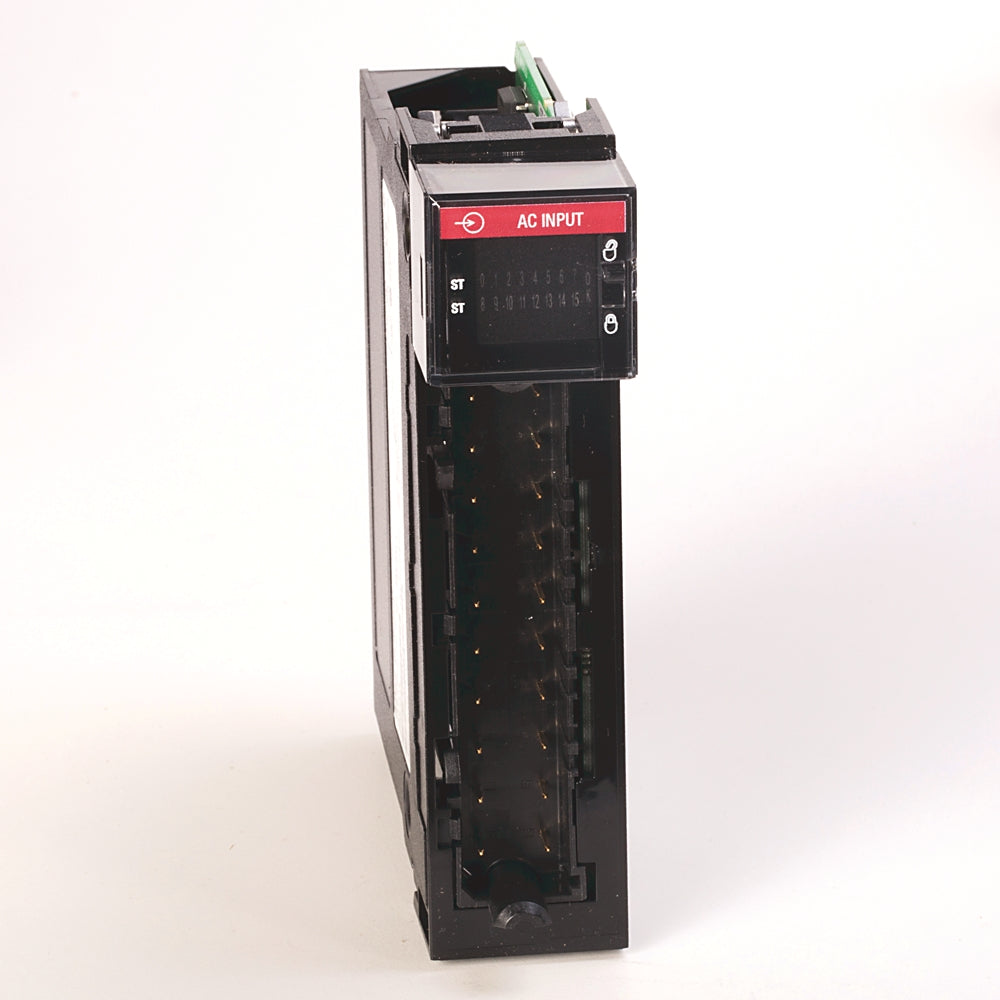

1756-IF16 | Allen-Bradley ControlLogix Analog Input Module, Current/Voltage, 16-Ch
- Regular price
- $529.00
- Sale price
- $529.00
- Regular price
-
Couldn't load pickup availability
Do you need help?
Product Description P/N: 1756-IF16
Description
The Allen-Bradley 1756-IF16 is a ControlLogix analog input module designed for interfacing current and voltage signals with automation controllers. It provides up to 16 single-ended, 8 differential, or 4 high-speed differential analog inputs, making it suitable for diverse industrial applications.
Technical Specifications
| Brand | Allen-Bradley |
| Series | ControlLogix |
| Part Number | 1756-IF16 |
| Manufacturer | Rockwell Automation |
| Data format | Integer mode (left justified, 2 s complement) IEEE 32-bit floating point |
| Module conversion method | Sigma-Delta |
| Removable Terminal Block (RTB) | 1756-TBCH 1756-TBS6H |
| Total Backplane power | 2.33 W |
| Backplane Current, 24VDC | 65 mA |
| Backplane Current, 5.1VDC | 150 mA |
| Scan Time | 16 pt single-ended: 16-488 ms; 8 pt differential: 8-244 ms and 4 pt high-speed differential: 5-122 ms |
| Settling time | <80 ms to 5% of full-scale |
| Resolution | 320 µV/count (15 bits + sign bipolar) @ ±10.25V; 160 µV/count (16 bits) @ 0…10.25V: 80 µV/count (16 bits) @ 0…5.125V; 0.32 µA/count (16 bits) @ 0…20.5 mA |
| Analog signals | ±10V, 0-10V, 0-5V and 0-20 mA |
| No. of Inputs | 16 single ended, 8 differential or 4 differential (high speed) |
| Module Type | Analog Input module |
| Inputs | 16 single, 8 differential, 4 highspeed differential |
| Input Resolution | (+/-) 10.25 Volts, 0 to 5.125 Volts, 0 to 10.25 Volts |
| Backplane Current (5Volts) | 150 milliamps |
| Backplane Current (24Volts) | 65 milliamps |
| Power Dissipation (Max) | 2.3 Watts (Voltage), 3.9 Watts (Current) |
| Removeable Terminal Blocks | 1756-TBCH, 1756-TBS6H |
| Maximum Input Current, Off-State | 1.5 milliamperes |
| Power Consumption | 2.3 Watts |
Information About 1756-IF16
The 1756-IF16 is part of the ControlLogix I/O family from Allen-Bradley, engineered to deliver high-performance analog data acquisition. It supports input ranges of ±10V, 0–10V, 0–5V, and 0–20 mA, allowing flexible integration with a wide range of industrial sensors and transmitters. The module offers a resolution of up to 16 bits, with precise scaling values such as 320 µV/count at ±10.25V and 0.32 µA/count at 0–20.5 mA, ensuring accurate signal representation. Its conversion is based on the sigma-delta method, with selectable data formats including integer mode and IEEE 32-bit floating point. The module requires removable terminal blocks (1756-TBCH or 1756-TBS6H) for wiring, providing flexibility and ease of installation. With configurable scan times and robust noise rejection through differential wiring, the 1756-IF16 is essential for control systems requiring precise analog input processing.
Key Features:
- Input Channels: Configurable as 16 single-ended, 8 differential, or 4 high-speed differential channels.
- Signal Ranges: Accepts ±10V, 0–10V, 0–5V, and 0–20 mA inputs for versatile application use.
- Resolution: High precision with up to 16-bit resolution, ensuring accurate signal measurement.
- Conversion Method: Sigma-delta conversion for stable and reliable signal processing.
- Data Format: Supports integer mode (left-justified, 2’s complement) and IEEE 32-bit floating point.
- Performance: Fast scan times ranging from 5 ms to 488 ms depending on configuration.
- Power: Consumes 150 mA at 5.1VDC and 65 mA at 24VDC, with max power dissipation of 3.9 W.
- Integration: Designed for use with 1756-TBCH or 1756-TBS6H removable terminal blocks for simplified wiring.
The 1756-IF16 delivers the reliability and precision required for high-performance analog data acquisition in ControlLogix automation systems.
Manufacturer information
Allen-Bradley, a brand of Rockwell Automation, specializes in manufacturing industrial automation equipment. The product range includes programmable logic controllers (PLCs), motion control systems, safety devices, motor control equipment, automation software, and HMI panels. Allen-Bradley products are known for their reliability and integration with other systems.
Description
The Allen-Bradley 1756-IF16 is a ControlLogix analog input module designed for interfacing current and voltage signals with automation controllers. It provides up to 16 single-ended, 8 differential, or 4 high-speed differential analog inputs, making it suitable for diverse industrial applications.
Technical Specifications
| Brand | Allen-Bradley |
| Series | ControlLogix |
| Part Number | 1756-IF16 |
| Manufacturer | Rockwell Automation |
| Data format | Integer mode (left justified, 2 s complement) IEEE 32-bit floating point |
| Module conversion method | Sigma-Delta |
| Removable Terminal Block (RTB) | 1756-TBCH 1756-TBS6H |
| Total Backplane power | 2.33 W |
| Backplane Current, 24VDC | 65 mA |
| Backplane Current, 5.1VDC | 150 mA |
| Scan Time | 16 pt single-ended: 16-488 ms; 8 pt differential: 8-244 ms and 4 pt high-speed differential: 5-122 ms |
| Settling time | <80 ms to 5% of full-scale |
| Resolution | 320 µV/count (15 bits + sign bipolar) @ ±10.25V; 160 µV/count (16 bits) @ 0…10.25V: 80 µV/count (16 bits) @ 0…5.125V; 0.32 µA/count (16 bits) @ 0…20.5 mA |
| Analog signals | ±10V, 0-10V, 0-5V and 0-20 mA |
| No. of Inputs | 16 single ended, 8 differential or 4 differential (high speed) |
| Module Type | Analog Input module |
| Inputs | 16 single, 8 differential, 4 highspeed differential |
| Input Resolution | (+/-) 10.25 Volts, 0 to 5.125 Volts, 0 to 10.25 Volts |
| Backplane Current (5Volts) | 150 milliamps |
| Backplane Current (24Volts) | 65 milliamps |
| Power Dissipation (Max) | 2.3 Watts (Voltage), 3.9 Watts (Current) |
| Removeable Terminal Blocks | 1756-TBCH, 1756-TBS6H |
| Maximum Input Current, Off-State | 1.5 milliamperes |
| Power Consumption | 2.3 Watts |
Information About 1756-IF16
The 1756-IF16 is part of the ControlLogix I/O family from Allen-Bradley, engineered to deliver high-performance analog data acquisition. It supports input ranges of ±10V, 0–10V, 0–5V, and 0–20 mA, allowing flexible integration with a wide range of industrial sensors and transmitters. The module offers a resolution of up to 16 bits, with precise scaling values such as 320 µV/count at ±10.25V and 0.32 µA/count at 0–20.5 mA, ensuring accurate signal representation. Its conversion is based on the sigma-delta method, with selectable data formats including integer mode and IEEE 32-bit floating point. The module requires removable terminal blocks (1756-TBCH or 1756-TBS6H) for wiring, providing flexibility and ease of installation. With configurable scan times and robust noise rejection through differential wiring, the 1756-IF16 is essential for control systems requiring precise analog input processing.
Key Features:
- Input Channels: Configurable as 16 single-ended, 8 differential, or 4 high-speed differential channels.
- Signal Ranges: Accepts ±10V, 0–10V, 0–5V, and 0–20 mA inputs for versatile application use.
- Resolution: High precision with up to 16-bit resolution, ensuring accurate signal measurement.
- Conversion Method: Sigma-delta conversion for stable and reliable signal processing.
- Data Format: Supports integer mode (left-justified, 2’s complement) and IEEE 32-bit floating point.
- Performance: Fast scan times ranging from 5 ms to 488 ms depending on configuration.
- Power: Consumes 150 mA at 5.1VDC and 65 mA at 24VDC, with max power dissipation of 3.9 W.
- Integration: Designed for use with 1756-TBCH or 1756-TBS6H removable terminal blocks for simplified wiring.
The 1756-IF16 delivers the reliability and precision required for high-performance analog data acquisition in ControlLogix automation systems.
Manufacturer information
Allen-Bradley, a brand of Rockwell Automation, specializes in manufacturing industrial automation equipment. The product range includes programmable logic controllers (PLCs), motion control systems, safety devices, motor control equipment, automation software, and HMI panels. Allen-Bradley products are known for their reliability and integration with other systems.


